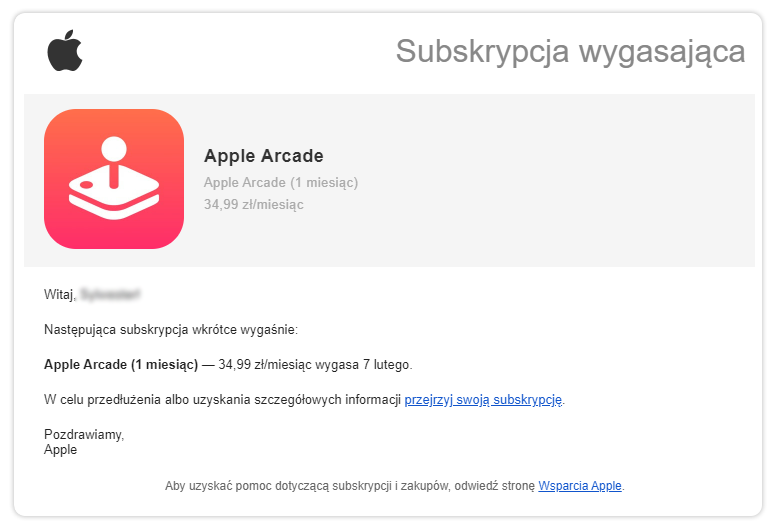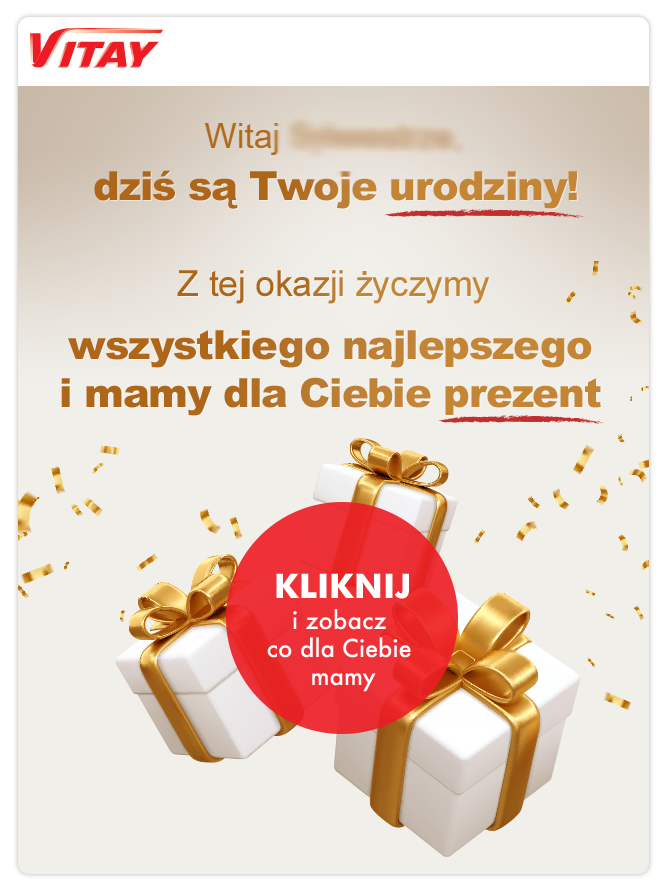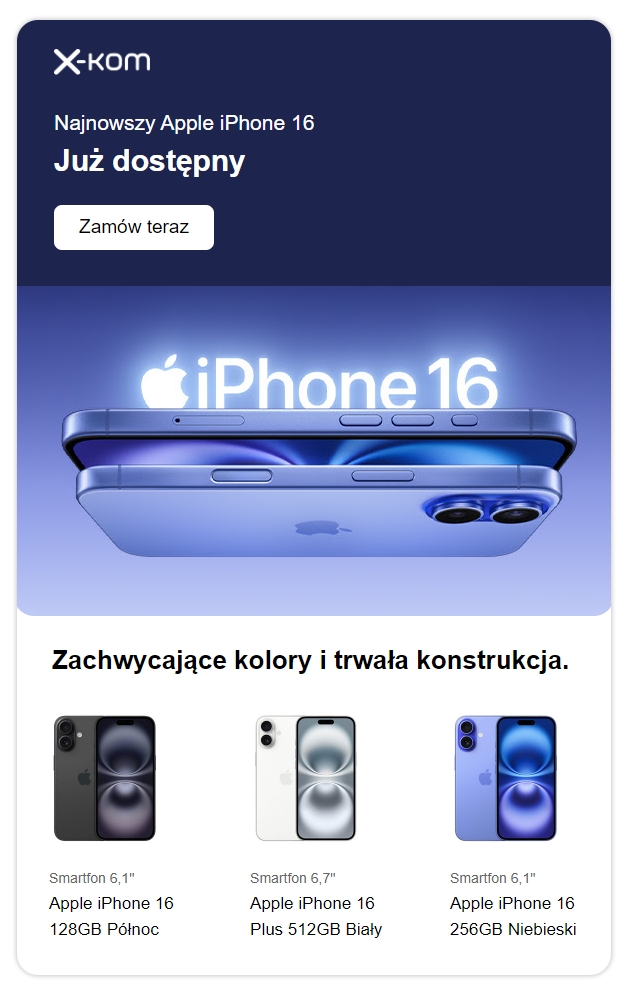What is email marketing in e-commerce?
E-mail marketing for online stores involves sending e-mails to specified groups or individual recipients. Within the framework of e-mail marketing, it is possible to conduct simple, but also complex and precise activities.
An example of a simple campaign activity is to send an email with an offer to everyone subscribed to a mailing list. However, if you are looking for more effective methods, you can – using the right tools – send personalized messages in response to customer actions. In this way, you can respond not only to a purchase being made, but also to a shopping cart being abandoned or a product being added to a wish list. In this way, you can schedule messages to be sent at key moments of user interaction with your store.
Types of e-mail marketing
With email marketing, you can send welcome emails, promotional emails, sales emails, as well as messages about specific products (for example, launches), discount coupons, newsletters or customer service messages. The above list, while long, is certainly not complete – emails can serve many marketing purposes. We will discuss them later in the article.
The basics of email marketing
It’s time to get acquainted with the fundamentals of email marketing. First we’ll try to understand their popularity, and then we’ll discuss how to attract email recipients and how to make your company’s messages stand out from the rest.
Low entry threshold and infinite possibilities
The popularity of e-mail marketing did not come out of nowhere.
First of all: the entry threshold is extremely low. All you need is an email account on a company domain, recipients’ addresses and you can already launch your first campaign. Manual mailing may not be convenient, but it is possible.
Second: the potential of email marketing is immeasurable. With the right tools, through automation and data capture, you can create campaigns that will significantly impact your store’s sales. Achieving the results you dream of, however, requires much deeper knowledge and mastery of sometimes complex tools.
Important!
Whether you want to start with a simple mailing to potential or existing customers or you intend to run extensive campaigns right away, you need to comply with the law – including obtaining consents for marketing communications from the recipients of your messages.
Get subscribers
Without a list of people to whom you can send messages, you can’t implement any email marketing campaign. So how do you get the recipients of your marketing communications? The possibilities are many:
First: place the subscription form on your store’s website – it’s good for it to appear on the homepage, or you can create a separate subpage for this purpose.
Second: Inform about the subscription in other places as well – under blog posts, on landing pages.
Third: Include the ability to sign up for a mailing list as an option when creating an account with the store.
Fourth: Plan rewards for signing up for the newsletter – a discount, free delivery or other incentives.
After Friday: Create lead magnets to encourage subscribers to sign up.
Sixth: Include information about the opportunity to sign up for the newsletter at key points in the customer journey – for example, after registration or after making a purchase.
Seventh: Get subscribers offline as well – for example, in stationary stores (if you have one) or at industry events.
Eighth: Having lead magnets ready, such as discount coupons, loyalty program points or free product samples, promote them off the site as well – for example, on social media.
Get the right approvals
Data protection laws have changed dramatically over the past few years. Regulations implemented under RODO (in the European Union) or CAN-SPAM (in the U.S.) require a number of conditions before commercial emails can be sent, but also impose conditions. Some apply to the content present in the header, others mandate that subscribers be allowed to easily opt-out at any time.
With the introduction of new regulations, the practice of buying mailing lists has become – from a legal point of view – pointless. However, it is worth noting that it has always been controversial and part of the so-called “gray zone.
Stand out in the crowd
Check your own mailbox – how many emails do you get every day? Ten? A hundred? Or maybe even more? So if you want your messages to be – first – noticed and then read, you need to make sure they stand out.
The first element that the recipient notices is the headline of the email. Make sure it fits within the character limit, tells what the email will be about, and at the same time arouses interest. Avoid clickbait, which may work once or twice, but only frustrate readers in the long run.
The graphic design of the email is also not insignificant. Once you’ve encouraged recipients to open the message, make sure the content is laid out in an easy-to-read manner. You may also be tempted to create a company template or add a footer to make it easier for recipients to contact your store.
Important!
Remember to communicate with your subscribers regularly. Don’t overdo the number of emails, but consider the fact that if a customer, after signing up for your newsletter, doesn’t hear from your company, he may simply forget about it. As a result, when you finally get back to him with an offer, he may treat it as SPAM.
Why does email marketing in an online store work so well?
A low threshold for entry is not the only reason companies are turning to email marketing. This technique can bring your store a number of specific benefits. Among them you will find:
High ROI (return on investment)
Email marketing is relatively inexpensive, especially if you contrast this method with regular social media advertising or influencer marketing. The low cost makes it easier to get a big return on investment from marketing activities carried out through the email channel.
Opportunity to build customer relationships
By collecting a mailing list, you simultaneously gain a simple way to communicate directly with your customers – potential, current or those who visited your store before and now no longer do so.
You can categorize your recipients to deliver more tailored content and offers, you can inform them about store changes, promotions and special offers. Any form of communication you dream of can be implemented through email marketing. What’s more, you don’t have to rely on companies other than your email service provider. You are not limited by social media algorithms – all emails you send will reach their addressees.
Support in the fight for customer retention
There is no doubt that it is cheaper – and overall: better – to keep a customer than to get a new one. Unfortunately, “cheaper” and “better” does not mean “easier.” Many customers will come to your store once. Maybe it’s because they found the product they’re interested in cheapest, or maybe it’s because your store showed up at the top of the search results.
However, if you make an effort to obtain the email address of every new customer (for example, by offering a discount on their first purchase in exchange for filling out a sign-up form), you will gain the ability to communicate with them (and remind them of your store’s existence).
Clear and instant results
By using techniques such as time-limited offers, you can significantly increase sales in a short period of time. In every other aspect, by the way, emails are easy to track. With the right tool, you can easily check how many recipients opened the email, how many of them clicked on the link inside, and what the final conversion rate (sales) was.
This makes you able to evaluate the results of an email campaign in a short time and, depending on the result achieved, congratulate yourself and start counting the profits, or make the necessary adjustments.
Examples of e-mail marketing activities
Email marketing is a bottomless well that can still be drawn from. Every now and then, new, increasingly effective and modern ways of using e-marketing emerge. Here are the most popular examples of activities that can make a significant difference in how your online store is perceived and the sales you make.
Automatic emails
Email marketing automation is a real gamechanger. With tools like HubSpot and MailChimp, you can respond immediately to almost every action a customer takes on your store’s website. So we’ll include emails sent after an order is placed, an account is created or a customer joins a newsletter. There’s even more.
Welcome emails
Saying hello to a new customer is a move that may not make that one put money on the table immediately, but it’s a nice gesture that can be a good entry into a new customer-company relationship. You can also use the welcome email to thank them for registering and to confirm their registration (include a verification link in the same message).
Use this opportunity to make a good first impression – there will be no second opportunity.

Thank you emails
Are you asking a customer to fill out a survey or leave feedback? Or maybe someone took advantage of a promotion in your store or entered a contest? For each of these actions, you should thank them. Such an e-mail serves two functions. First: it is a confirmation of the action performed (you managed to send the form, it arrived and we have your response), and second: it is another element of building a relationship with the recipients of your emails.
Thank you emails are also about evoking positive emotions. If a customer has been wrestling with his or her thoughts for a long time about whether he or she should make a particular purchase, your email simply thanking him or her for a successful transaction and appreciating that the buyer chose your store will be a positive, nice signal sent in the customer’s direction.
Emails when shopping carts are abandoned
Abandoned shopping carts are a common problem. It happens to everyone to add several products to the shopping cart and then – for various reasons – not complete the purchase. With automation, you can send an email to each customer who abandons the shopping cart. In the message, it is worth reminding about the products that are left in the shopping cart, possibly offering a special discount (of course, this cannot become a rule).

Reminder emails
Do you sell services or software on a subscription model? You can remind your customers of an upcoming payment or the expiration of a subscription (if the subscription expires on its own). This way you will remain transparent and show that you care about your customers. Of course, some of them will take the opportunity to cancel their subscriptions, but those who stay will certainly appreciate the move.

Birthday mail
Although it’s a small thing, a birthday email can be a pleasant surprise for a customer. If you ask for a date of birth at registration, there’s nothing stopping you from sending a customer a short email once a year to wish them well and thank them for their purchases. Birthdays are also an opportunity to give gifts – it can be a discount on purchases, a free product for the next order or a voucher.

Sales email
This is actually the most typical way to use email marketing. A sales message can be any e-mail in which you offer subscribers the opportunity to purchase a product. Here are some examples:
Mail for product launch
Are you launching a new service or starting a (pre)sale of a product that many have been waiting for? Let your subscribers know about it, let them know that the offer is limited (by time or number of products), and maybe even add a bonus when they buy in the pre-sale? It could be a discount, points in a loyalty program or a voucher for future purchases.
Sometimes – if the product is sufficiently well-known and desirable – all that is needed is information:

Mail with promotional offer
If you are preparing a big promotion, you are doing it to increase sales. In this situation, sending an email to your subscribers is the absolute basic action you can take. Many of your customers do not buy at full prices almost as a matter of principle, and information about the promotion may be all they need to make a purchase.
By organizing sales (for example, on a single product category) you generate interest and encourage people to go to the store’s website. There, in turn, if the store is properly structured, the customer will have sufficient opportunity to shop.
Product email
Another example that doesn’t quite fit into any of the previous categories is prospecting, which is the search for potential customers. This is a set of activities that are used to acquire leads that match the company’s profile. Prospecting involves first creating a customer persona, then researching the market and the selected target group, and finally contacting potential customers – for example, through cold mailing. However, this technique is mostly used in B2B sales – mainly for legal reasons.
When dealing with individual customers (B2C), current regulations actually prevent the implementation of cold mailing activities, since these involve sending marketing messages to recipients who have not yet had contact with the company (and therefore have not given their consent to marketing communications either).
Summary
You already know how to start implementing email marketing. However, this is just the beginning. Ahead of you is the selection of the right tool, the sending of the first promotional emails, the first A/B tests, and plenty of opportunities for direct contact with customers.
Remember not to send messages to customers who don’t want them. Review your mailing list from time to time and manually remove inactive addresses or the effects of bots that fill out forms. Also, remember to give an unsubscribe option in each message.


